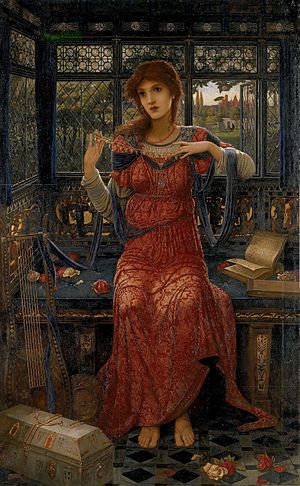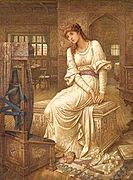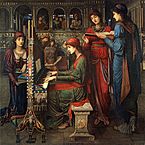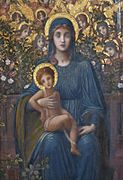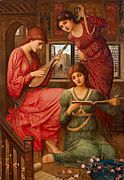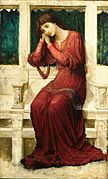John Melhuish Strudwick facts for kids
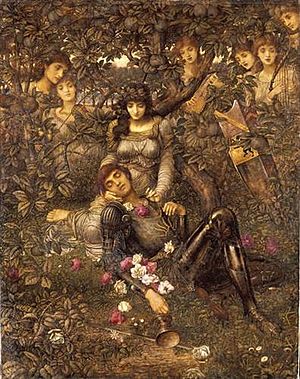
John Melhuish Strudwick (born May 6, 1849, in Clapham, London – died July 16, 1937, in Hammersmith) was a British painter. He was part of the Pre-Raphaelite art movement, known for its detailed and colorful style inspired by earlier art.
Contents
Early Life and Education
John Melhuish Strudwick was born in London to William and Sarah Strudwick. He went to St Saviour's Grammar School in Southwark. John didn't want a business job. Instead, he chose to study art. He took classes at the Royal Academy Schools in South Kensington. At first, people didn't think he was a very promising art student.
Becoming a Painter
In the 1860s, a Scottish painter named John Pettie encouraged John Strudwick. Strudwick even copied Pettie's style for a while. An example of his early work is a painting called 'Auld Robin Gray', shown in 1873.
His art style changed a lot in the 1870s. He worked as an assistant for two famous artists: his uncle John Roddam Spencer Stanhope and then Edward Burne-Jones. Working with these artists helped him develop his own unique style.
Strudwick showed his paintings in important London galleries. These included the Grosvenor Gallery and the New Gallery. His art studio was in Hammersmith, close to Burne-Jones's studio.
John Strudwick married Harriet Reed. They had one daughter, Ethel (1880–1954). Ethel later became the headmistress of St Paul's Girls' School. She was also awarded the CBE honor.
Art Style and Themes
Strudwick's paintings mixed styles from the Middle Ages and the Renaissance. He paid very close attention to small details. This was especially true for the clothes and objects in his paintings. Because of this careful work, he didn't produce many paintings.
About thirty of his paintings show stories from legends and symbols. He often used a special painting technique from the Italian quattrocento period. His artworks featured rich, deep colors. The faces in his paintings often looked like those in Burne-Jones's work. He also painted beautiful, flowing fabrics.
A critic named Frederic George Stephens often wrote negative reviews about Strudwick's art. However, many people still admired his detailed and beautiful work.
Later Life and Famous Works
When John Strudwick passed away, The Times newspaper wrote about him. They described him as "a beautiful old man" and "a charming personality." They also said he was very kind to young artists.
One of Strudwick's well-known paintings is called "Thy Music, faintly falling, dies away, Thy dear eyes dream that Love will live for aye". This painting has been owned by famous people, including writer Sir Tim Rice. It was first bought by a shipowner named William Imrie. The title of the painting comes from a poem by George Frederick Bodley, a famous architect linked to the Pre-Raphaelite movement.
Another painting, The Gentle Music of a Bygone Day, was sold for a large amount of money at an auction in 1993.
Gallery


